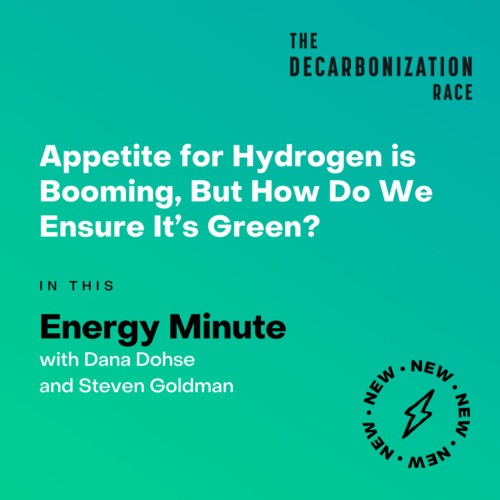
Energy Minute: Appetite for Hydrogen is Booming, But How Do We Ensure It’s Green?
Episode · 0 Play
Episode · 22:48 · May 8, 2023
About
Hydrogen is used as a heat source, a fuel or a feedstock in a range of industries… but depending on how it’s made, it can be a boon or hazard to our climate. Shifting to zero-carbon “green hydrogen” - produced using renewable energy sources like solar and wind - is critical for using hydrogen as a decarbonization resource, so much so that both the United States and European Union have passed legislation and targets aimed at quickly growing hydrogen adoption. But making sure hydrogen production is indeed green is complicated, and the choices we make today will have big impacts on how quickly hydrogen use grows, and how much it helps or hurts the climate challenge in the process. In this Energy Minute, Dana Dohse and Steven Goldman explore the complex world of hydrogen and the efforts to ensure its production is sustainable and decarbonized. They discuss the challenges of transitioning from grey to green hydrogen, the debate over how incentives should be structured to avoid decarbonizing the grid, and some of the ways hydrogen fits into the overarching goal of decarbonizing heavy industries. Key Takeaways The most common type of hydrogen produced today is “grey hydrogen,” made by heating and reacting methane to break its carbon and hydrogen bonds, creating carbon emissions in the process. “Blue hydrogen” is made by capturing and storing the resulting carbon emissions in geologic formations like caverns, or built storage facilities under high pressure. If captured and stored properly, that process can abate about 90% of emissions associated with making grey hydrogen. The key accelerator of green hydrogen projects in the United States is the Section 45V Production Tax Credit passed as part of the Inflation Reduction Act legislation. The 45V tax credit is a scaling tax credit tied to lifecycle hydrogen emissions through the point of production, based on how much lower the emissions from hydrogen production are relative to grey hydrogen. The highest tax credit level is set at $3 per kilogram of hydrogen, but how production qualifies is yet to be finalized by the U.S. Treasury.. The hydrogen “color wheel” refers to the different colors used to represent different methods and energy inputs for producing hydrogen. Grey hydrogen is produced by breaking natural gas; black and brown hydrogen respectively by converting different types of coal into syngas, then breaking that like natural gas; turquoise hydrogen by breaking natural gas and producing hydrogen and solid carbon through pyrolysis; green hydrogen by powering an electrolyzer with renewable energy to split water; and pink hydrogen by powering an electrolyzer with nuclear energy to split water. The framework that a coalition of renewables and electrolyzer developers, midstream companies, think tanks, academics and nonprofits have advocated for calls for three principles: 1) additionality, requiring electrolyzers to draw power from new sources of clean electricity brought online as a direct result of that electrolyzer’s construction; 2) deliverability, requiring that electrolyzers use local sources of clean electricity that are physically deliverable to the electrolyzer site; and 3) time-matching, requiring that electrolyzers run at the same time as clean electricity generation. References IEA report, “The Future of Hydrogen” Renewable Thermal Collaborative report, “Green Hydrogen Technical Assessment” Energy Innovation research note, “Smart Design of 45V Hydrogen Production Tax Credit Will Reduce Emissions and Grow the Industry” Natural Resources Defense Council blog post, “Success of IRA Hydrogen Tax Credit Hinges on IRS and DOE” Spectra, “Europe Sets Rules for Producing Green Hydrogen” Green Hydrogen Catapult
22m 48s · May 8, 2023
© 2023 Libsyn